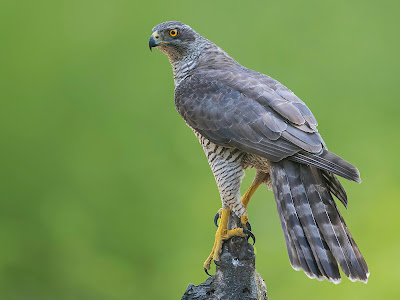In these days of
climate change and wholesale destruction of nature, we hang all hopes for the
future on nature’s resilience. That
resilience is the theme underlying Helen Macdonald’s memoir H Is For Hawk (Grove Press, 2014). Hers is a triangulated story shifting from
her father’s death to the life of Arthurian legend writer T.H. White to
Macdonald’s training of Mabel the goshawk, the medium-large raptor Accipiter gentilis of the title. If these seem like strange bedfellows,
Macdonald makes these transitions smoothly and by the end of the book, weaves a
story of personal redemption and self-discovery that is both wise and profound.
T. H. White also wrote a book about raising and training a goshawk, and Macdonald turns to the celebrated author’s book as a guide for her own journey with Mabel. He was not as prepared as Macdonald, and therefore his account is more fraught with difficulty and disappointment. Yet he is a touchstone for Macdonald, a connection to an experience with an animal who has as much to teach her trainer as her trainer has to understand this predatory bird. With a goshawk, however, there is no taming her nature; Macdonald, with great difficulty, simply trains the bird to follow her own instincts as a hunter of prey, and human and hawk learn to work as a unit on the hunt.
Macdonald’s father was a photojournalist who died in 2007. She recounts his passing while on the job, and how she had to go with family members to pick up his belongings and find his car, which had been towed away when he did not return to pick it up while covering his final story. Macdonald was very close to him, and the loss is almost overwhelming. Part of her own training is to learn to live with loss and grief. She recounts how her father taught her patience as the most important virtue. He tells her that one must be willing to stay still and wait for her moment, much like a piece of reindeer moss can survive “just about anything the world throws at it” and remain resilient. It is ironic that she finds herself staring at the moss when her mother informs her of her father’s passing.
The life of an Astringer—a solitary trainer of goshawks and sparrowhawks—is a lonely one, and Macdonald describes her daily life and routines with Mabel in poetic and deeply harmonic language. The setting of the book is the Brecklands, a place known as the broken lands, and the area lives up to its name. She clings to the words of Marianne Moore: “The cure for loneliness is solitude.” She tells us she has learned to hold tight and survive, much like the security of the jesses, leather straps that bind the hawk to the Astringer. Her twin brother did not survive the difficult birth that brought Macdonald into the world.
Macdonald is so good at distilling the wisdom she absorbs from training Mabel. She tells us there are two things she has learned about training hawks: the Astringer must learn to become invisible, and the way to a hawk’s heart is through positive reinforcement with food. Hawks are not social animals like dogs or horses. They are predators, and their predatory nature is bred in their bones. She equates training goshawks with “white-knuckle jobs” as described by her father. These are dangerous journalism assignments. Her father’s defense against the fear is to “look through the viewfinder” and stop being involved. Instead, become the witness. “All that exists is a square of finely ground glass and the world seen through it,” he tells her. His advice in stressful, dangerous situations is to be mindful of “exposure and depth of field and getting the shot you hope for.” Macdonald sees her father’s work in each photograph as “a record, a testament, a bulwark against forgetting, against nothingness, against death.”
 |
| Henri Cartier-Bresson |
Throughout the book, Macdonald’s writing is poetic and beautiful. She writes: “There is a time in life when you expect the world to be always full of new things. And then comes a day when you realize that is not how it will be at all. You see that life will become a thing made of holes. Absences. Losses. Things that were there and are no longer. And you realize, too, that you have to grow around and between the gaps, though you can put your hand out to where things were and feel that tense, shining dullness of the space where the memories are.”









